
How to Use ChatGPT to Write Emails: 2025 Guide
Writing emails shouldn’t take all day. But between staring at a blank screen and second-guessing every word, it often does.
That’s where AI steps in, and yes, we’re talking about everyone’s favorite writing assistant: ChatGPT.
With the right prompt, you can create an email in a few minutes. But if you want it to perform, you need a process that’ll help you craft messages that sound natural, feel on-brand, and get clicks, without starting from scratch every time.
In this guide, we’ll see how to use ChatGPT to write emails, the benefits of using an AI writing assistant, and helpful prompts for various occasions.
Disclaimer: While we’re using ChatGPT in this guide, you can follow a similar process with other AI writing tools like Copilot, Perplexity, or Gemini. The key is knowing how to guide the AI effectively.
The Benefits of Using ChatGPT to Write Emails
While you might think the main benefit of using ChatGPT is doing things faster, it’s really about working smarter.
When used effectively, you can organize your ideas, brainstorm, and refine your final draft. But the value doesn’t stop there. There’s more ChatGPT can do to support your email copywriting process.
Break through writer’s block
Sometimes, the hardest part of writing an email is just getting started. You know what you’re offering, who it’s for, and what you want to say, but the words don’t come.
ChatGPT can help you brainstorm even if you have only a few bullet points, turning your rough ideas into a first draft that you can shape and improve.
For example, let’s say you’re launching a new feature that allows users to schedule recurring invoices. You know the basics, but you’re unsure how to start your email.
You could start with something like: “We’ve just added a recurring invoice feature to help you save time on repeat billing.” Then give ChatGPT a prompt like: “Turn this into an email for current users. Keep it short, clear, and helpful.”
From there, it’ll generate a draft that captures your main message. It may not be perfect, but it’s a good starting point to build upon.
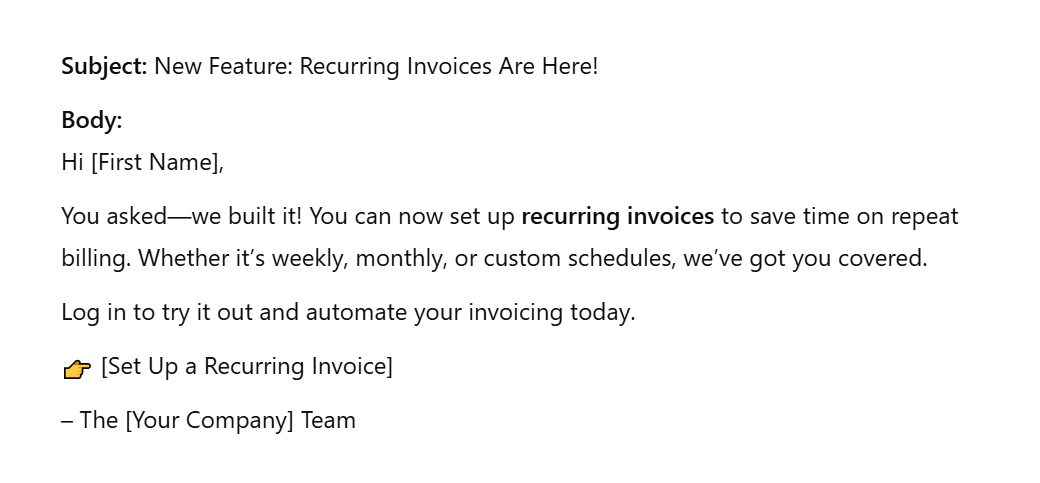
Adapt tone and style for different audiences
Not every email addresses the same audience. One day, you’re writing to loyal customers, while the next, it’s cold leads who’ve never heard of you. The core message might stay the same, but the tone should shift depending on who you’re talking to.
ChatGPT can adjust the tone of your text to suit your needs. For example, if your first draft sounds too formal for a younger audience segment, you can try a prompt like: “Make this sound more casual and friendly.” This way, you’ll get a new version that feels more in tune with them.
And if it still doesn’t hit the mark, you can go back and forth until it does without rewriting it from scratch every time.
Brainstorm subject lines, CTAs, and their variations
Aside from writing your email body, ChatGPT can also help you come up with subject lines and calls to action (CTAs), two key elements that can make or break your email.
The AI tool can suggest new ideas, improve what you already have, and offer quick variations to help you find the best.
For example, after writing your email, you can use a prompt like: “Give me 5 subject line ideas that create excitement and encourage clicks,” or “Suggest alternative CTAs that sound more friendly and less pushy than ‘Buy now.’”
It’s an easy way to explore different ideas and find something that aligns with your message and audience.
Polish and proofread content before sending
Once your draft is done, it’s easy to miss small mistakes or spots that could flow better.
ChatGPT can act as your editing tool to refine your writing quickly. For instance, you can ask it to proofread your email, fix awkward phrasing, or make things more concise.
You’ll get a smoother version that sounds polished and professional without spending extra time editing it line by line.
Repurpose existing content
If you’ve already created a blog post, feature update, or landing page, ChatGPT can help you repurpose your content into a well-structured email.
Just drop in the content and prompt something like: “Turn this blog post into a short email announcing the new feature to users.”
ChatGPT will extract the key points, adjust the tone, and refine everything into something suitable for an email campaign.
This saves time, keeps your messaging consistent across channels, and makes sure you’re getting more value out of the content you’ve already created.
Translate or localize your emails
If you’re reaching customers in different countries, ChatGPT can help you quickly translate or localize your emails.
It’s a great starting point when you need fast translations or want to adjust your message for a new market.
That said, it’s always a good idea to have a native speaker review the final version. ChatGPT can get you close, but a quick check will ensure your message sounds natural and culturally accurate.
Writing an Email with ChatGPT: Step-by-Step
If you want better emails, you need the right prompts, and that’s where the C.R.E.A.T.E. Framework comes in.
This process will let you guide ChatGPT step by step, ensuring you don’t receive generic text that requires extensive editing.
To show you how it works, let’s consider the scenario of launching a new summer skincare collection for an eCommerce brand. The goal will be to announce the latest products and get customers excited to shop.
1. Give ChatGPT context
The first step to get more relevant results is to provide ChatGPT with context. This means assigning it a role or “character,” so it knows who it’s writing as.
For example, when you tell ChatGPT it’s an email marketer for a skincare brand, it can better match your tone, audience, and goal.
Now, begin by clearly setting the context. Describe the role ChatGPT should take on, the type of email you’re writing, your brand, and your audience.
Here’s a simple prompt to do it.
Prompt: You’re an email marketer for an eCommerce skincare brand. Write a product launch email for our new summer collection. The audience includes returning customers and email subscribers. The tone should be fresh, fun, and designed to build excitement around the new products.
And here’s the output:
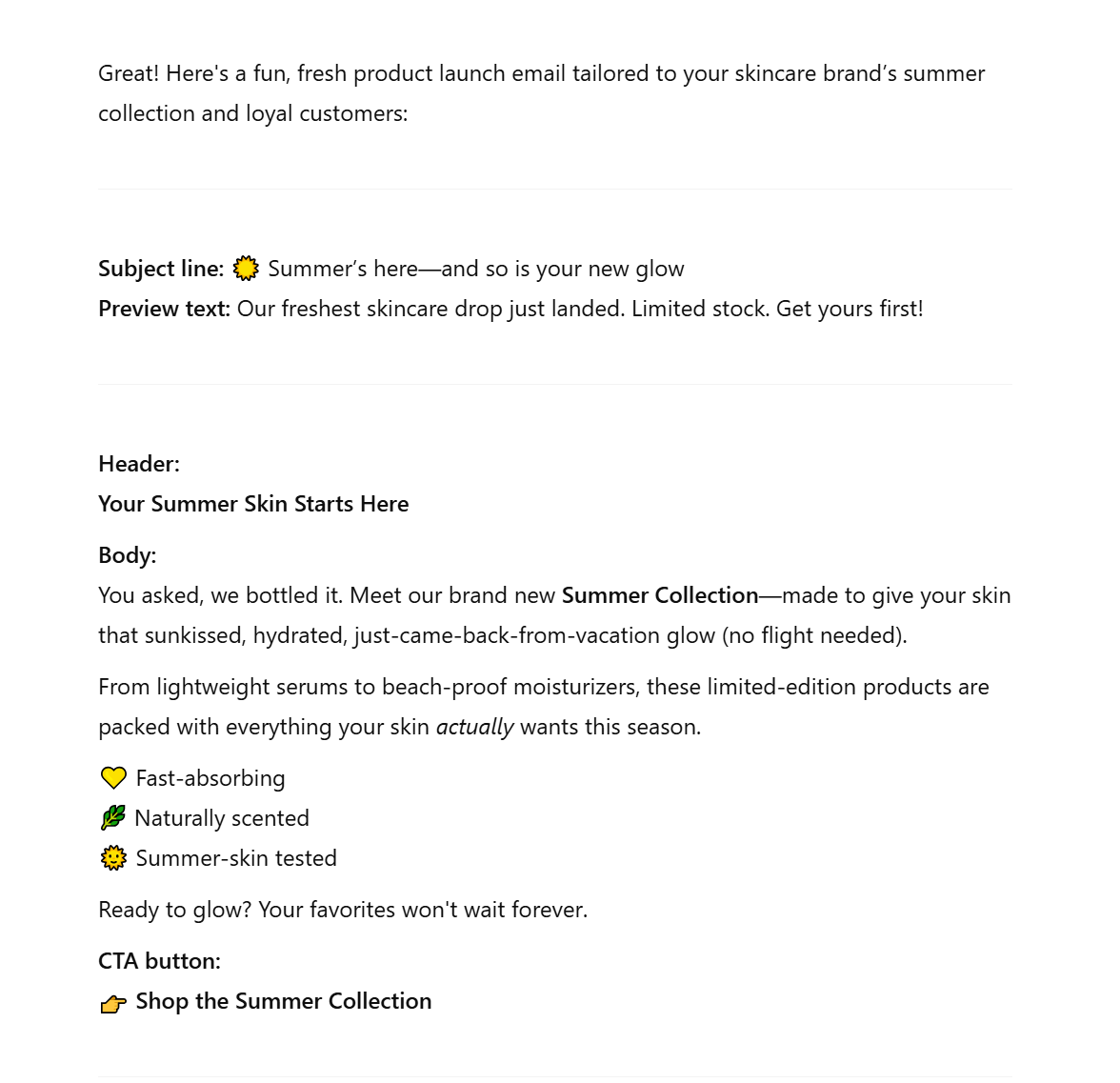
Tip: ChatGPT often writes in a very neutral or slightly formal tone by default. If you want something more playful or brand-specific (like using emojis, puns, or bold phrases), make sure to include that tone in your prompt.
2. Personalize your output
You got your first draft, now it’s time to add more details to personalize your email. The more information you give ChatGPT, the better the results.
To enhance your draft, provide the tool with the following details:
- Word limit
- Your brand name
- Collection name
- Launch date
- Promotion duration
- Subject line and preview text
- Specific call to action (CTA)
Here’s a simple prompt to personalize your promotional email.
Prompt: Customize the email above to include our brand name, Glam & Go, and mention that it’s for the Summer Skincare Drop. It features a Vitamin C serum, hydrating mist, and SPF moisturizer, launching on July 15. The CTA should invite people to shop the collection. Include a subject line and preview text.
Here’s the new output:
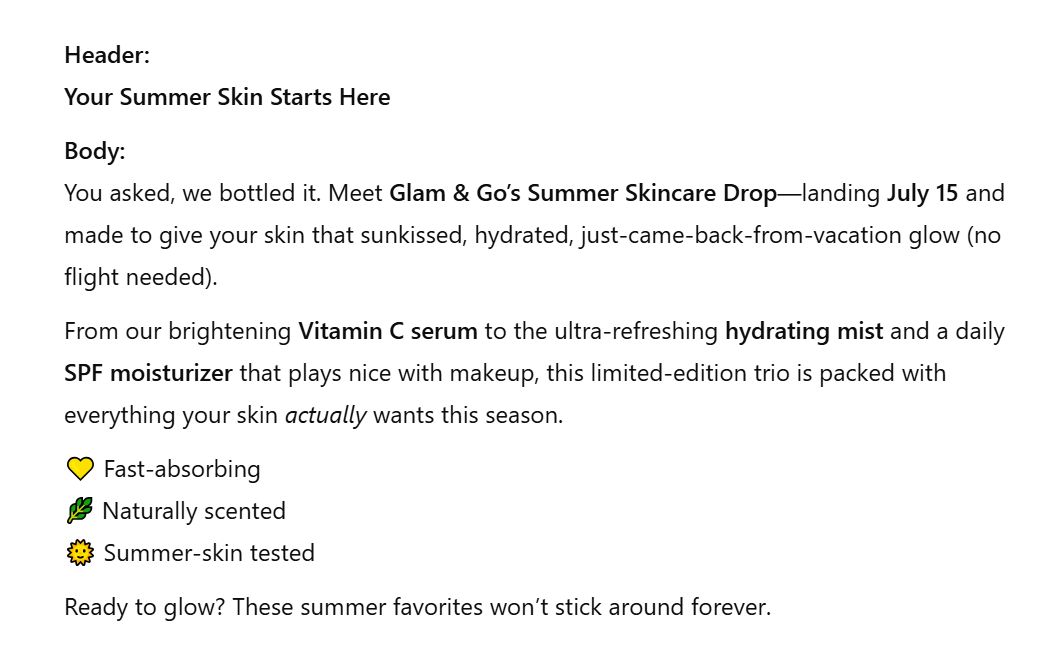
Tip: Ask ChatGPT not to use em dashes in the copy. They’re often associated with AI-generated text and can feel unnatural to readers. If your goal is to make emails feel human and easy to read, keeping punctuation simple helps your message blend in naturally with your brand voice.
3. Adjust the tone
With all the necessary details added, you now need to focus on the tone of your email. You can ask ChatGPT to adjust it to reflect your brand’s personality and your target audience.
Prompt 1: Rewrite this in a more casual tone, like you’re talking to loyal customers who love summer skincare.

Don’t stop at just one version, though. Try asking ChatGPT to rewrite it in different tones, such as playful, Gen Z-friendly, or even short and punchy, like a text.
To see how the AI writing tool can adapt tone and style, here’s a prompt asking for a more luxurious version of the same email, along with its output.
Prompt 2: Rewrite the email in a more luxurious and elevated tone for our VIP customers.
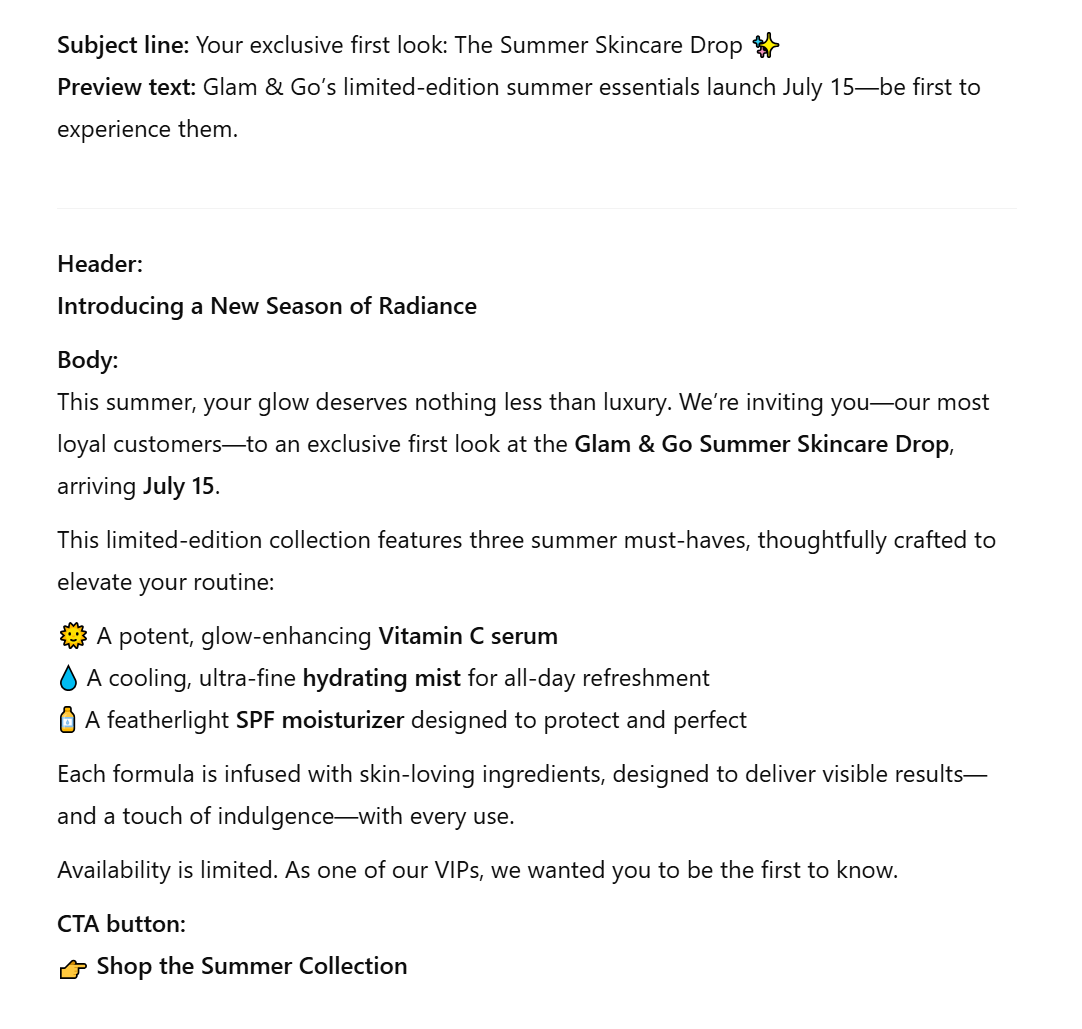
Tip: If you want ChatGPT to match your brand’s voice better, try adding a short sample of your usual tone or writing style in the prompt.
4. Test subject line variations
Your email subject line is what decides whether someone opens your email or skips right past it.
You can ask ChatGPT to generate subject line ideas based on your email content or write your own and have it refine them. From there, you can request variations, such as with emojis or urgency, or tweak the tone to match your audience and style.
Creation prompt: Write a subject line that is clear, catchy, and encourages customers to open the email. Make it feel fresh and seasonal. Include emojis.
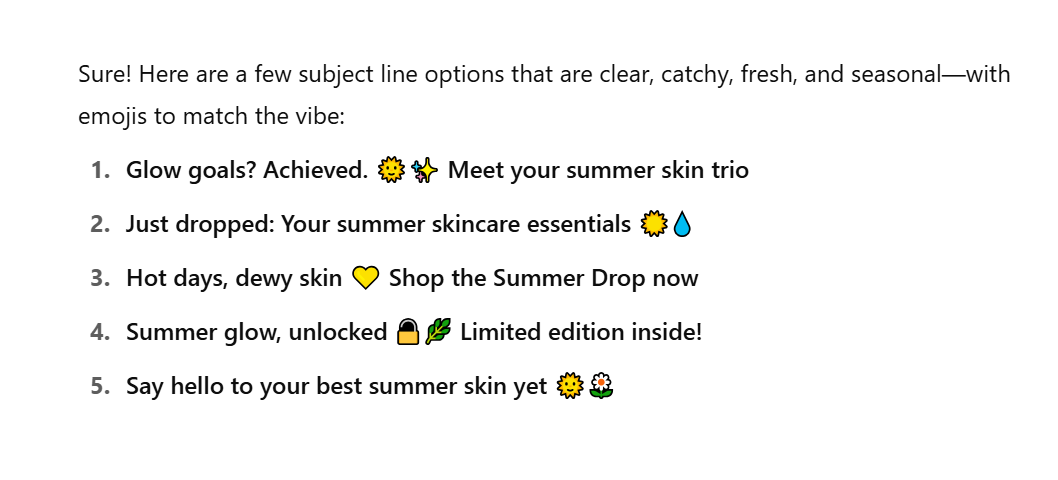
Now you can select the one you like and ask ChatGPT to rewrite it in different styles or formats to fit your audience.
Variation prompt: Give me 5 variations of this subject line, “Say hello to your best summer skin yet,” with different tones. Try playful, elegant, emoji-friendly, urgent, short, and punchy.
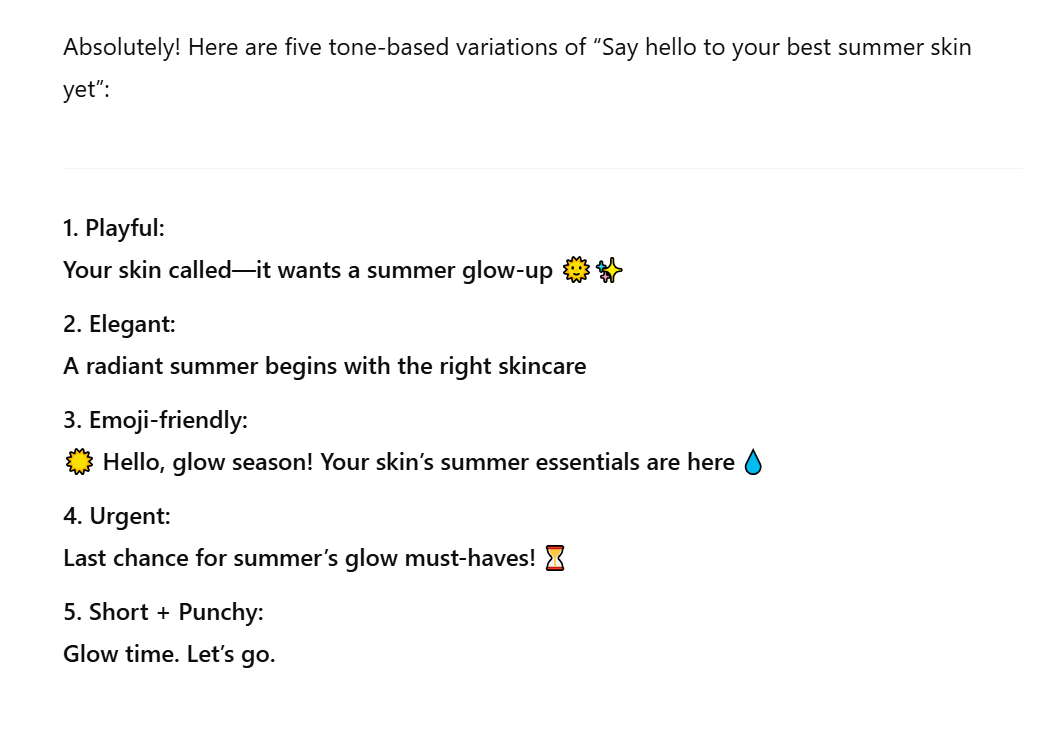
Tip: Keep subject lines short, clear, and focused on value. If you’re using emojis, stick to one or two as too many can feel spammy or turn off your audience. Less is more when it comes to inbox appeal.
5. Optimize your CTAs
Crafting a compelling CTA is key to converting interest into action.
Begin with a clear prompt tailored to your offer, asking ChatGPT to adjust the tone, urgency, or format to align with your campaign goals.
Creation prompt: Write a CTA for our limited-edition summer skincare collection. Make it clear, action-driven, and add a sense of urgency.
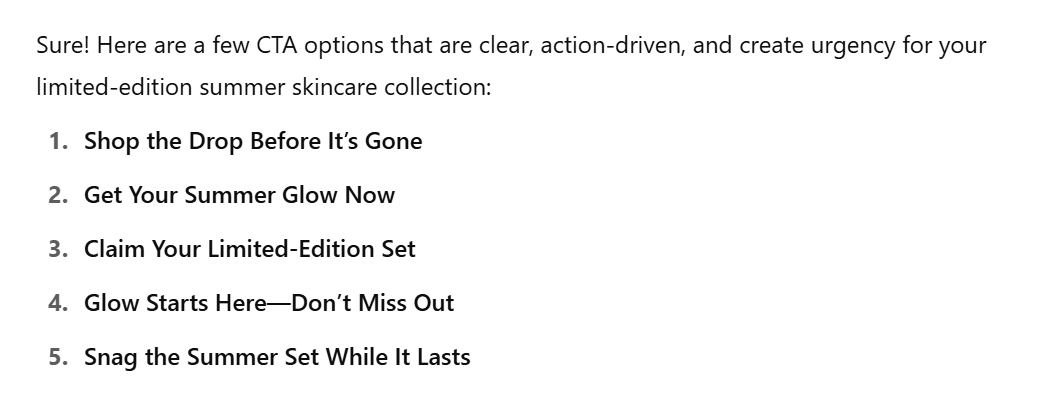
Also, if you have already created your own CTAs, you can ask ChatGPT for variations.
Variation prompt: Give me 5 CTA variations with different tones.
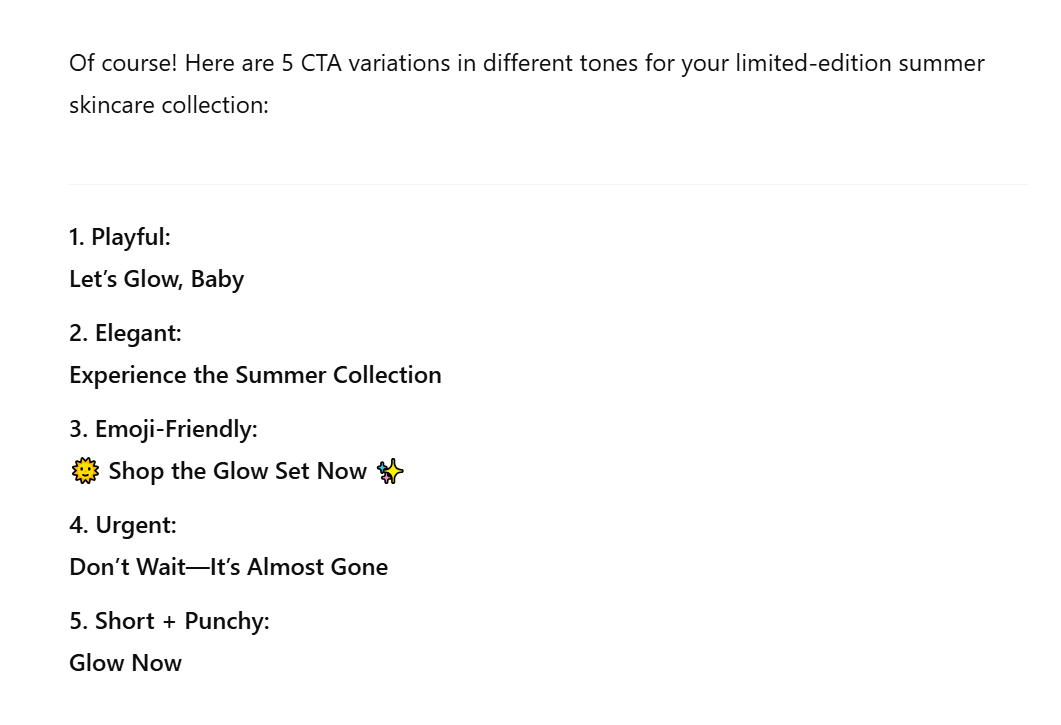
Tip: Like your subject lines, good CTAs need to be action-driven and specific. For instance, “Start your free trial” works better than a vague “Click here.” They should also create a sense of urgency or highlight a benefit, like “Get 20% off today” or “Book your spot now.”
6. Polish and proofread the final version
After you have followed all the above steps and added your personal touches, you can ask ChatGPT to help refine everything.
Among other things, ask it to catch grammatical mistakes, improve clarity, and polish your copy so it reads smoothly.
Prompt: Polish the final version of my email. [Insert your draft here]. Check for grammar, clarity, and flow. Make it clear, concise, and easy to read, while maintaining the friendly tone.
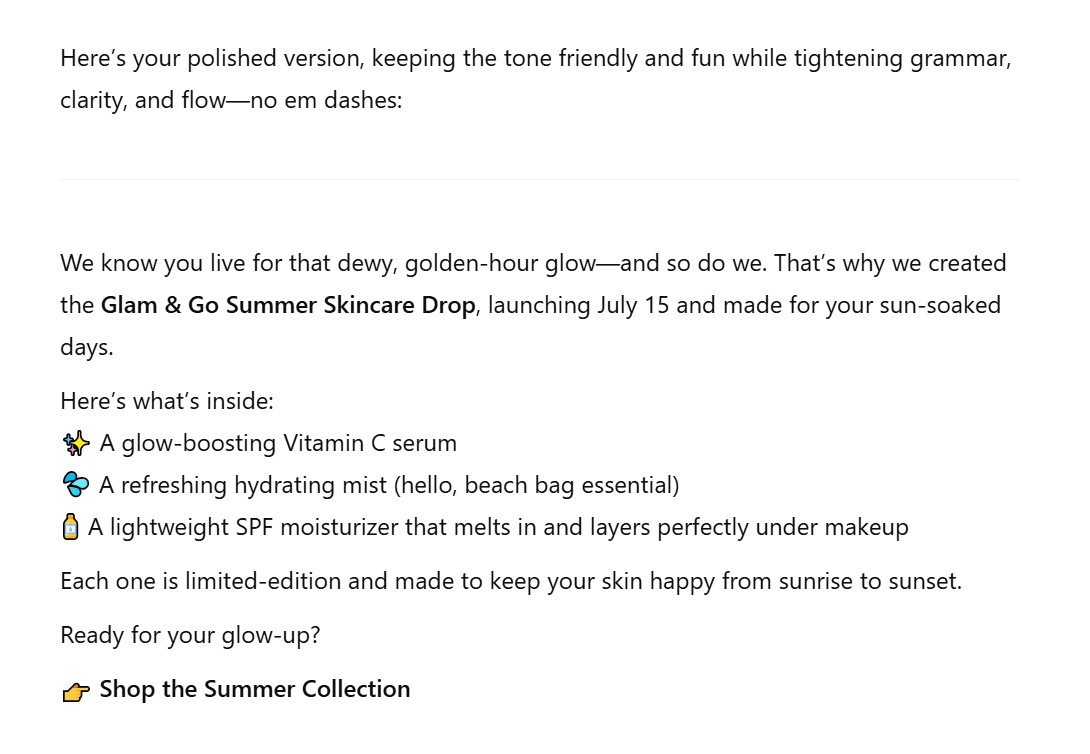
Checklist before you hit send:
- Read your email out loud to make sure it sounds natural and matches your voice.
- Ensure there are no overused phrases or filler that don’t add value.
- Break long text into short paragraphs for better readability.
- Remove random em dashes and fix punctuation.
- Bold key points or add line breaks to guide the reader’s eye.
Tip: If you still feel like it needs further polishing, ask ChatGPT to simplify the language, e.g., “Rewrite this to a 6th grade reading level.”
7. Ask for color palette suggestions or design ideas
Your email body, subject line, and CTA might be ready, but there’s one more piece to consider: the design.
ChatGPT can help you brainstorm email design ideas, from layout suggestions to color palettes that fit your product and brand.
For example, since we’re launching a summer skincare collection, we can ask for visuals that are fresh and vibrant,
Prompt: Suggest a color palette and design direction for my email promoting our Summer Skincare Drop. I want it to feel fresh and vibrant.

Tip: To get results that match your brand, include your brand’s colors and fonts in the prompt. You can also ask ChatGPT to suggest complementary shades or font pairings that keep the design feeling fresh without straying off-brand.
8. Visualize your emails
Now that your email copy is polished and your design ideas are in place, it’s time to bring it all together. A visual mockup helps you (and your team) see how everything fits, from header to CTA.
Prompt: Create a mockup of my email using this: [final version of your email copy].
Here’s an example of how our Glam & Go summer email might look:
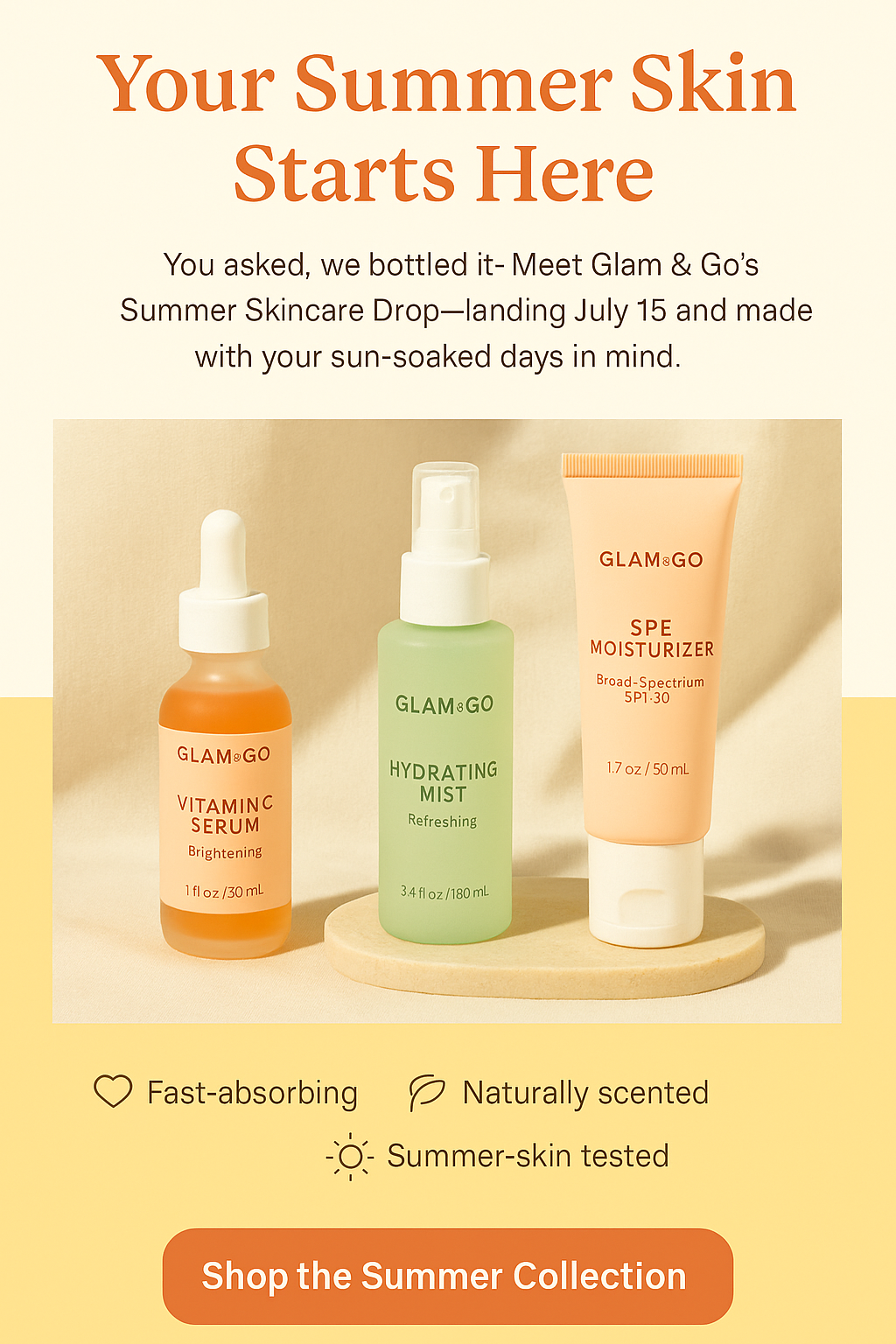
Only use examples like this to get inspired, not as your final version. AI-generated images contain minor and major design flaws, including typos (SPE instead of SPF), misaligned text, uneven spacing, and off-brand elements that aren’t suitable for your actual email.
Instead, think of it as a blueprint you can hand off to your design team. When they provide you with high-quality visuals, you can then start working on your email design.
Most email tools also offer responsive templates you can easily customize with your:
- Brand visuals
- Copy from ChatGPT
- Product images and CTA buttons
Moosend, for example, gives you access to a wide range of pre-designed templates that you can drag, drop, and adjust according to your needs.
Plus, its built-in AI email marketing tools, such as the AI Writer, will help you optimize your content directly in the editor, so you don’t have to switch back and forth between ChatGPT and your email platform.
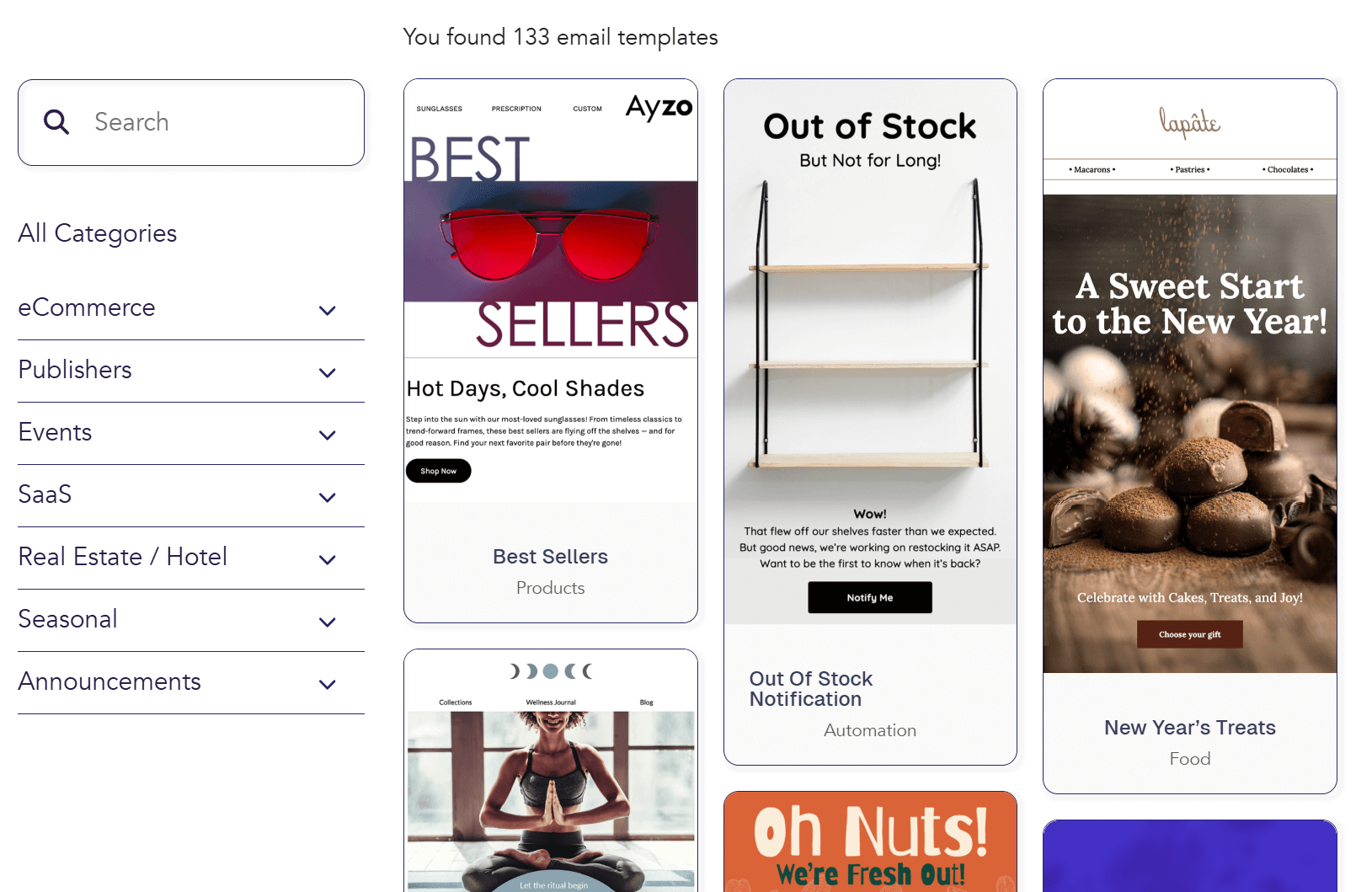
With everything in place, you’re now ready to create your next email marketing campaign.
Prompts for Different Types of Emails [with Output]
Different emails require different tones, goals, and structures, and ChatGPT can help you address them all.
Below are simple, ready-to-use prompts for common email types to help you move from idea to send faster. Don’t forget to further personalize them to get more relevant input.
Before you use them: To get the most out of these prompts, make sure to include your brand details when you use them, including your brand name, website URL, tone of voice, and target audience.
Here’s a reusable prompt template based on the C.R.E.A.T.E framework you can copy and adjust each time.
Base prompt: You’re an email marketer for [Brand Name], a [type of business] with a [tone/style] voice. The website is [yourwebsite.com] and the audience includes [describe your audience].
You can add this before any of the prompt examples below to get results that match your brand faster and with less back-and-forth editing.
ChatGPT prompt for welcome emails
Instead of just saying “welcome,” give ChatGPT the right context to craft a message that sets expectations and reflects your brand. Add details like your tone, what new subscribers can expect, and any unique brand touches you want included.
Prompt: Write a welcome email for new subscribers. Thank them for joining, introduce the brand briefly, and offer a first-time discount code.
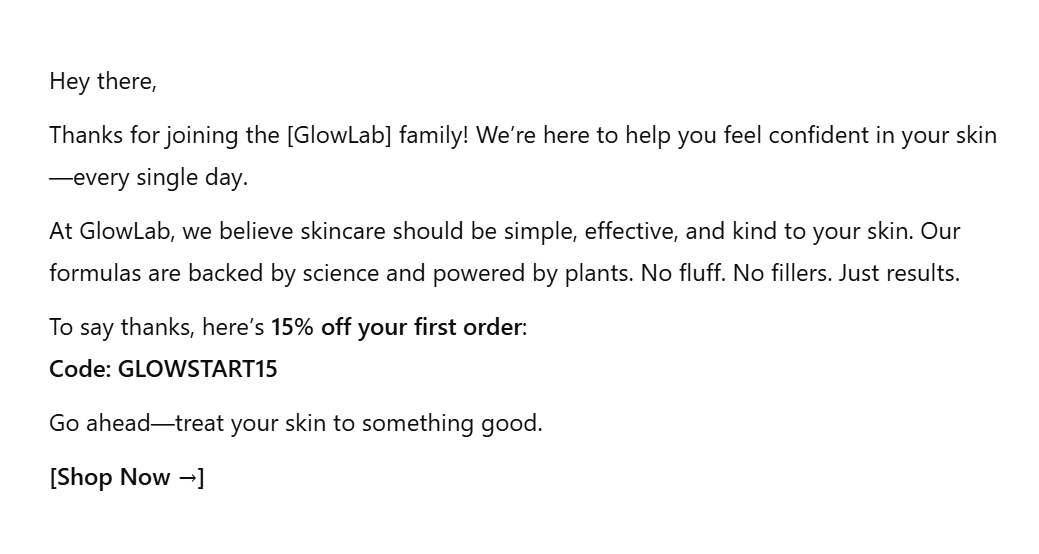
Further reading: Check out these welcome email examples from real brands to get inspired.
ChatGPT prompt for re-engagement email
It’s usually easier to write to someone who already wants to hear from you. But when it comes to winning back inactive subscribers, you might need a little extra help. To improve your chances, use your prompt to include what they’ve missed, why they should come back, and the kind of offer or message that feels worth their attention.
Prompt: Write a re-engagement email for inactive customers. Remind them of the benefits of [your product/service] and include a 10% off code to encourage them to come back.
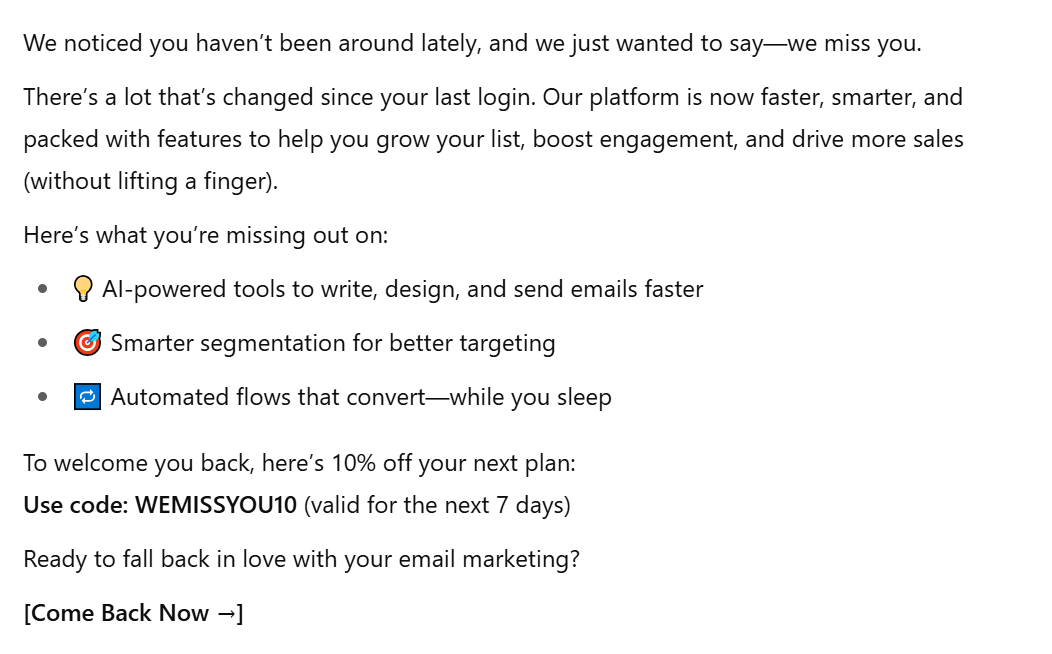
Further reading: Discover more re-engagement campaigns in our dedicated blog post.
ChatGPT prompt for abandoned cart reminders
Abandoned cart emails work best when they’re timely and helpful. In your prompt, include what was left behind, any urgency or discount you want to add, and the tone you’d like ChatGPT to use, such as friendly, playful, or straight to the point.
Prompt: Write a cart abandonment email for a customer who left a product in their cart. Keep the tone warm and helpful and include a CTA to return to the checkout page.
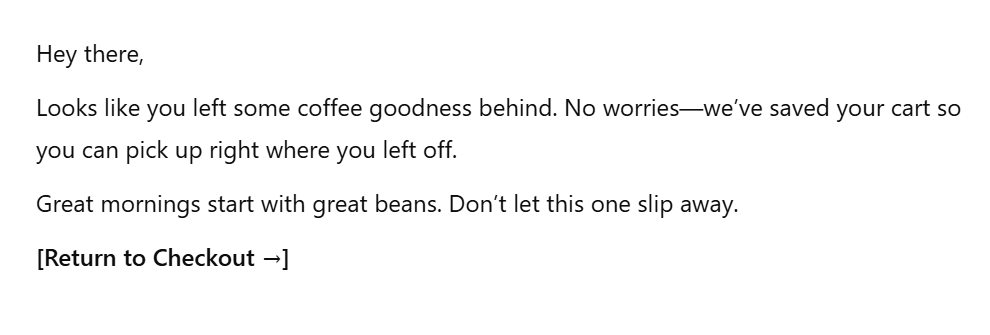
Additional resources:
- Abandoned Cart Email Templates
- Best Abandoned Cart Email Examples & Templates [2025]
- Cart Abandonment Stats To Reduce Your Lost Sales
ChatGPT prompt for onboarding new customers
Help new customers get started with confidence. In your prompt, include what they should do first, what makes your product or service valuable, and the tone you want to use. For example, you can go for supportive, enthusiastic, or simple and clear.
Prompt: Write an onboarding email for new [customer/users]. Help them get started with setting up their first [task]. Keep it [tone].
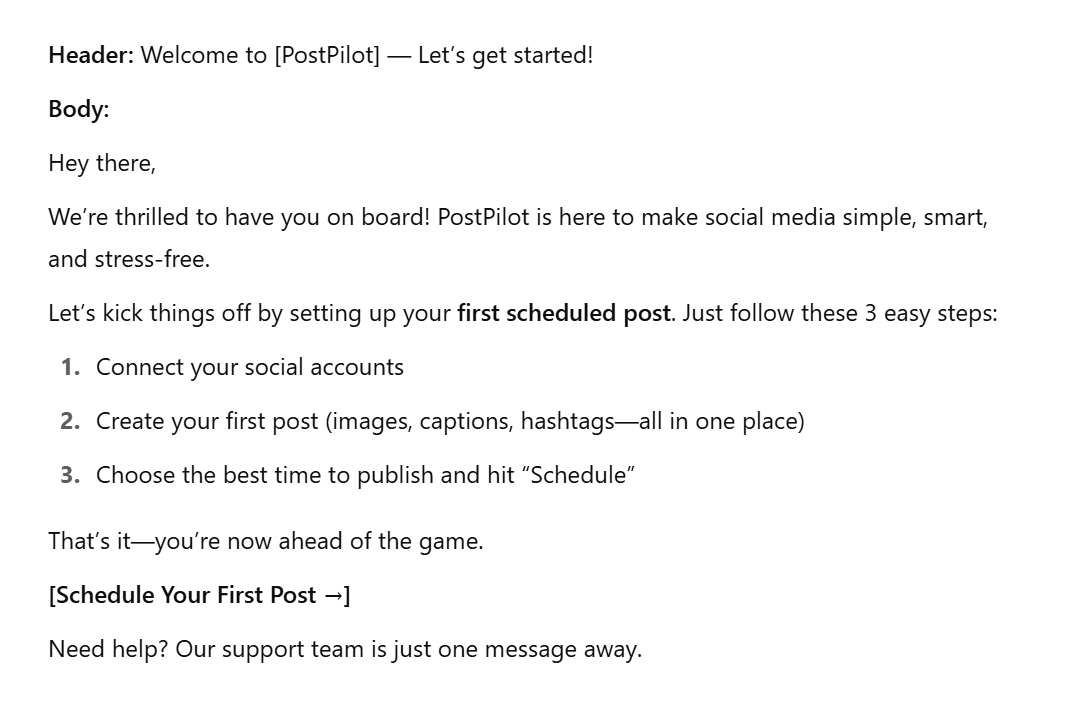
Further reading: For more onboarding email examples, take a look at our guide.
ChatGPT prompt for subscription renewals
For renewal or upgrade emails, clarity is key. Use your prompt to include the renewal date, plan details, and any benefits of upgrading.
Prompt: Write a membership renewal reminder for my customers. Encourage them to renew their subscription and consider upgrading to the Pro plan by highlighting premium features and offering a limited-time discount.
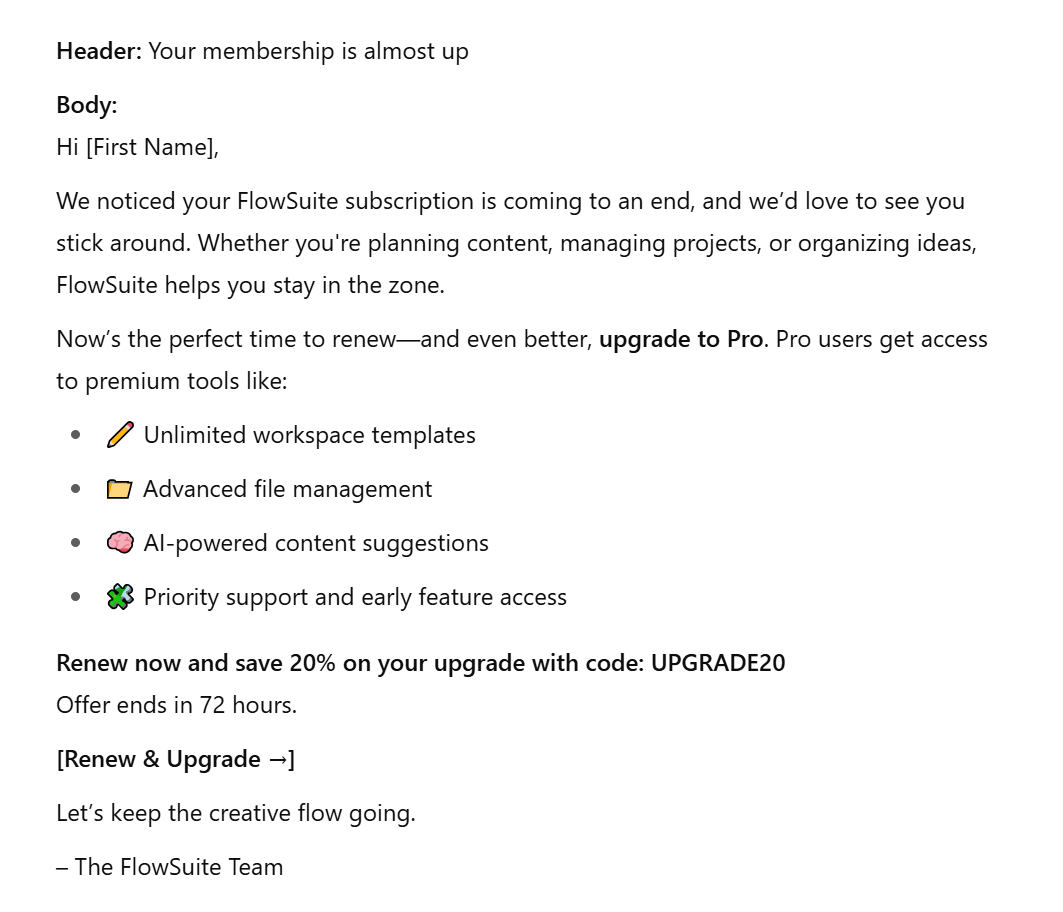
ChatGPT prompt for cancellation emails
Leave a good impression even if they’re leaving. You can thank them, offer help, and ask for feedback.
Prompt: Write a cancellation confirmation email for [your brand]. Keep the tone understanding and friendly. Include a link for feedback and an invitation to return anytime.
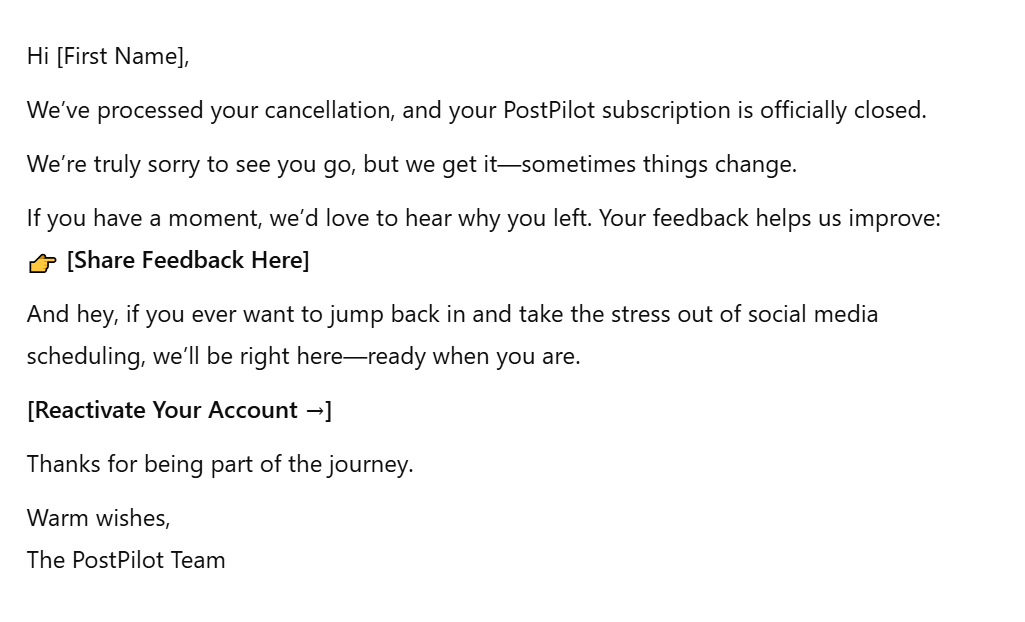
Further reading: Discover more cancellation email examples in our guide.
ChatGPT prompt for limited-time sales
Sales don’t last forever, and your email should reflect that. In your prompt, include the discount, end date, and any standout product categories. If you want ChatGPT to add urgency without sounding pushy, make sure to mention the tone you’re going for.
Prompt: Write a promotional email for a 3-day summer sale. Highlight 20% off sitewide. Keep the tone upbeat and add urgency to shop before it ends.
ChatGPT prompt for events
Let subscribers join your online and offline events with a simple email. Use your prompt to include the event name, date, location (or link), and what makes it worth joining. You can also ask ChatGPT to help you highlight key speakers, sessions, or perks.
Prompt: Write an event invitation email for [event name]. Highlight the date, key benefits (like pro tips and live demos), and include a clear CTA to register. Keep the tone informative and add urgency by noting limited spots.

ChatGPT prompt for feedback emails
Asking for feedback shows you care and helps you improve. In your prompt, include what kind of feedback you’re looking for, whether it’s about a product, service, or overall experience. You can also link to a short survey to make it easy for subscribers to respond.
Prompt: Write a post-purchase feedback email for my customers who recently [performed action/general feedback]. Thank them warmly, ask for a quick review, and include a link to leave feedback. Maintain a friendly and appreciative tone and acknowledge how their input contributes to the improvement of future products.
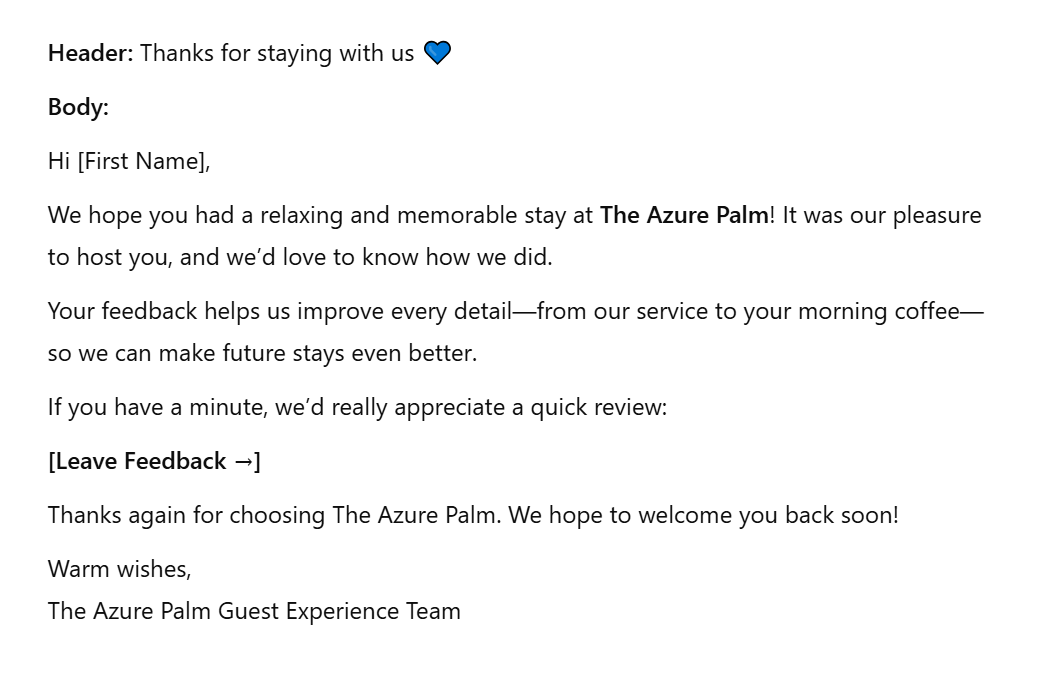
Using ChatGPT to Write Smarter Emails
ChatGPT won’t write your emails for you, but it can make the whole process easier.
The key isn’t just asking it to “write an email,” but guiding it with clear prompts, refining what you get, and shaping the output to fit your voice. With the right process in place, it’ll save you time without costing you quality.
And once your copy is ready, tools like Moosend will let you bring it to life with easy-to-customize templates. Just sign up for a free account and see how you can combine smart copy with effortless design.
FAQs
Let’s take a look at some common questions regarding ChatGPT.
1. Is ChatGPT free?
Yes, ChatGPT offers a free plan that anyone can use. There’s also a paid version called ChatGPT Plus, which gives access to advanced features and the latest GPT model.
2. How to use ChatGPT?
To use ChatGPT, visit chat.openai.com, create an account, and begin typing your questions or prompts. It works like a chat, where you ask a question and it responds in real time.
3. Do I need both ChatGPT Plus and an email marketing tool to write better emails?
You can get started with the free version of ChatGPT, but if you’re serious about using it in your email workflow, upgrading to ChatGPT Plus is worth it. It gives you access to the latest model, which generates higher-quality copy with better tone and structure. That said, you’ll still need a separate email marketing tool to design and send your campaigns, meaning two different tools (and costs). An alternative is to use a platform like Moosend, which includes built-in AI Writers. That way, you can write, refine, and send emails all in one without switching tools or paying extra.
4. Is ChatGPT safe?
ChatGPT is designed with safety in mind and follows strict content guidelines. However, like any AI tool, it’s important to avoid sharing sensitive personal information. Use it responsibly, and if something doesn’t feel right, report it.
5. Is ChatGPT content plagiarism-free?
ChatGPT generates original content based on patterns in the data it was trained on. It doesn’t copy from sources, but it’s always a good idea to review the content and use a plagiarism checker if you’re publishing or submitting the text professionally.
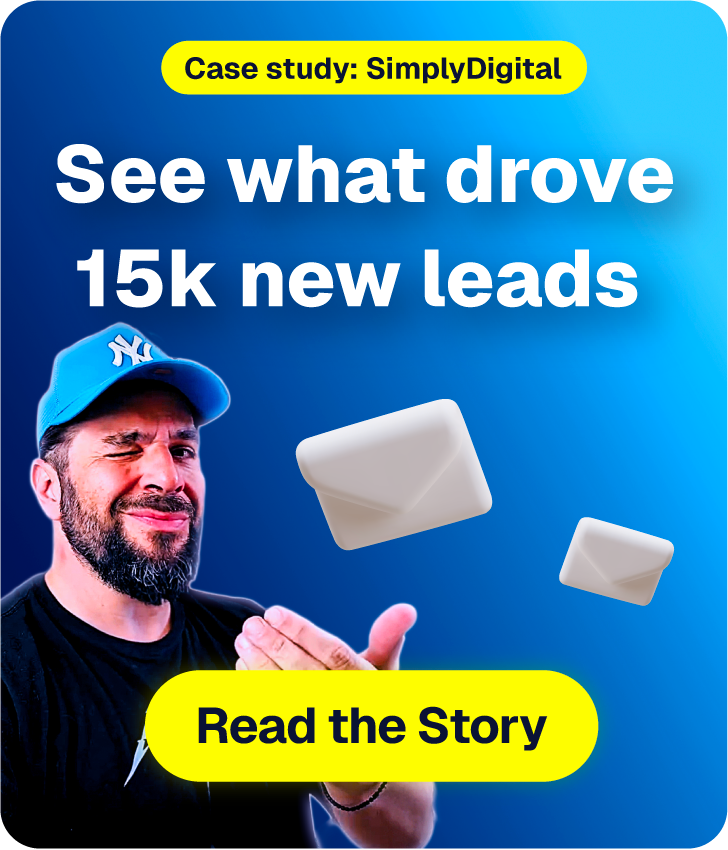




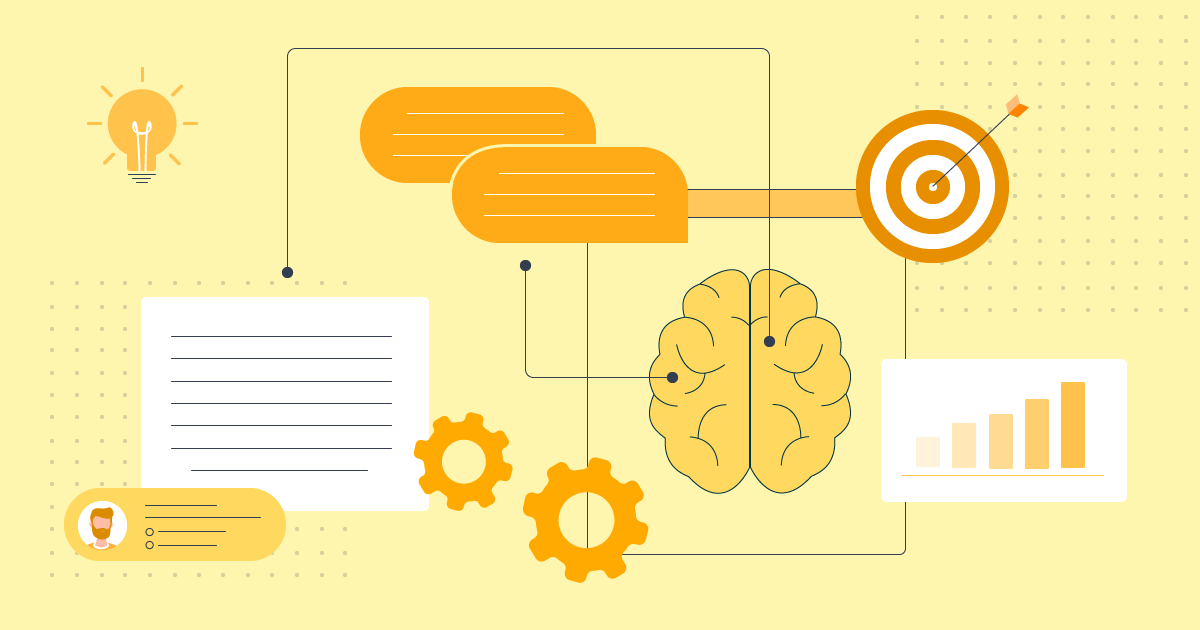
 Published by
Published by